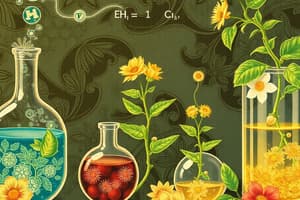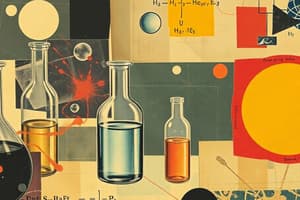Podcast
Questions and Answers
Flashcards
What type of reaction is the reaction of calcium oxide with water?
What type of reaction is the reaction of calcium oxide with water?
The reaction of calcium oxide with water is an exothermic reaction, releasing heat.
What is the balanced equation for the combustion of propane (C3H8) in oxygen?
What is the balanced equation for the combustion of propane (C3H8) in oxygen?
The balanced equation for the combustion of propane is C3H8 + 5O2 → 3CO2 + 4H2O. This represents one molecule of propane reacting with five molecules of oxygen to generate three molecules of carbon dioxide and four molecules of water.
Which material is most suitable for making the core of an electromagnet?
Which material is most suitable for making the core of an electromagnet?
Iron is the most suitable material for the core of an electromagnet due to its strong ferromagnetic properties, meaning it readily attracts and concentrates magnetic fields.
What is the product formed when an acid reacts with a base?
What is the product formed when an acid reacts with a base?
Signup and view all the flashcards
What device converts electrical energy into mechanical energy?
What device converts electrical energy into mechanical energy?
Signup and view all the flashcards
What does the refractive index of a medium depend on?
What does the refractive index of a medium depend on?
Signup and view all the flashcards
What actions are controlled by the medulla oblongata?
What actions are controlled by the medulla oblongata?
Signup and view all the flashcards
According to the right-hand thumb rule, if the thumb points in the direction of the current, what do the fingers curl in the direction of?
According to the right-hand thumb rule, if the thumb points in the direction of the current, what do the fingers curl in the direction of?
Signup and view all the flashcards
How many chambers are in a fish's heart?
How many chambers are in a fish's heart?
Signup and view all the flashcards
Which part of the eye provides color to it?
Which part of the eye provides color to it?
Signup and view all the flashcards
In what way is the flow of energy in a food chain?
In what way is the flow of energy in a food chain?
Signup and view all the flashcards
What gas is evolved when an acid reacts with a metal?
What gas is evolved when an acid reacts with a metal?
Signup and view all the flashcards
What organs are involved in reflex action?
What organs are involved in reflex action?
Signup and view all the flashcards
Do acids have a pH value greater or less than 7?
Do acids have a pH value greater or less than 7?
Signup and view all the flashcards
What is the relationship between the mass of the products and reactants in a chemical reaction?
What is the relationship between the mass of the products and reactants in a chemical reaction?
Signup and view all the flashcards
When does refraction of light occur?
When does refraction of light occur?
Signup and view all the flashcards
Are all metals ductile and can be drawn into wires?
Are all metals ductile and can be drawn into wires?
Signup and view all the flashcards
What cells in the human eye are responsible for vision?
What cells in the human eye are responsible for vision?
Signup and view all the flashcards
What is a strong acid?
What is a strong acid?
Signup and view all the flashcards
What happens in an endothermic reaction?
What happens in an endothermic reaction?
Signup and view all the flashcards
Which part of the brain controls involuntary actions?
Which part of the brain controls involuntary actions?
Signup and view all the flashcards
What is DNA?
What is DNA?
Signup and view all the flashcards
Who is known for establishing the fundamental laws of genetics?
Who is known for establishing the fundamental laws of genetics?
Signup and view all the flashcards
What does “aq” indicate in a chemical equation?
What does “aq” indicate in a chemical equation?
Signup and view all the flashcards
Give an example of two metals that have low melting points?
Give an example of two metals that have low melting points?
Signup and view all the flashcards
What is the direction of the magnetic field lines outside a bar magnet?
What is the direction of the magnetic field lines outside a bar magnet?
Signup and view all the flashcards
What is the normal blood pressure of a human?
What is the normal blood pressure of a human?
Signup and view all the flashcards
Which part of the human brain is specialized for thinking, hearing, smelling, seeing, etc.?
Which part of the human brain is specialized for thinking, hearing, smelling, seeing, etc.?
Signup and view all the flashcards
Which lens is used to correct myopia?
Which lens is used to correct myopia?
Signup and view all the flashcards
What is the chemical formula of ethene?
What is the chemical formula of ethene?
Signup and view all the flashcards
What is the function of saliva?
What is the function of saliva?
Signup and view all the flashcards
Study Notes
Instructions and Marks
- All questions are compulsory
- Draw diagrams where necessary
- Marks for each question are indicated
- 1-5 are objective type questions (30 marks total)
- 6-17 are 2 marks each (30 words max)
- 18-20 are 3 marks each (75 words max)
- 21-23 are 4 marks each (120 words max)
- Internal options available for questions 6-23
Objective Questions
- Questions 1-5 are objective type questions totaling 30 marks
Other Questions
- Questions 6-23 have internal options
- Word limits are provided for each
Multiple Choice Questions
- Question 1: Calcium oxide reacting with water is an exothermic reaction
- Question 2: Balanced equation for propane combustion: C3H8 + 5O2 → 3CO2 + 4H2O
- Question 3: Best material for electromagnet core is iron.
True/False Statements
- The organs involved in reflex action are spinal cord, motor neuron and brain (True)
- Acids have a pH value greater than 7 (False)
- In a chemical reaction, the mass of the products is always equal to the mass of the reactants. (True)
- Refraction occurs when light travels from one medium to another at the same speed. (False)
- All metals are ductile and can be drawn into wires. (True)
- The retina in the human eye contains rod and cone cells for vision. (True)
Matching
| Column A | Column B |
|---|---|
| Strong acid | Laws of Genetics |
| Absorption of heat | Endothermic reaction |
| Cerebellum | Controls involuntary actions |
| DNA | Substance dissolved in water |
| Mendel | Genes |
| “aq” | Indicates substance dissolved in water |
Short Answer Type Questions
- Two examples of metals with low melting point (not provided in text)
- Direction of magnetic field lines outside a bar magnet (not provided in text)
- Normal blood pressure of a human (not provided in text)
- Part of human brain specialized for thinking, hearing, smelling, seeing etc. (not provided in text)
- Lens for correcting myopia is a concave lens
- Formula for ethane is C2H6
- Draw electron dot structure of methane or ethane (drawings not possible in this format)
Component Symbols
- Symbols for battery and resistance in circuit diagrams (drawings not possible in this format)
Factors Affecting Resistance
- Factors affecting resistance (not provided in detail)
Why Stars Twinkle
- Explanation for why stars twinkle (not provided in detail)
- Reason why sky looks blue (not provided in detail)
Bryophyllum Reproduction
- How Bryophyllum leaves reproduce (not provided in detail)
- Process of binary fission in Amoeba (not provided in detail)
- Difference between endothermic and exothermic reactions (not provided in detail)
Oxidation/Reduction
- Definition of oxidation and reduction reaction (not provided in detail)
Significance of Mendel's Law
- Significance of Mendel's law of segregation (not provided in detail)
- Mendel's law of dominance with an example (not provided in detail)
Diagram of Human Excretory System
- Diagram of human excretory system (drawing not possible in this format)
Heart Valves
- Names and functions of two heart valves (not provided in detail)
Reflex Action
- Definition of reflex action with an example (not provided in detail)
- Role of neurons in the human body (not provided in detail)
Ohm's Law
- Statement of Ohm's law and mathematical expression (not provided in detail)
- Calculation of total resistance of three resistors in series (not provided in detail)
15. Refractive Index and Lens Power
- Definition of refractive index, refractive index of water (not provided in detail)
- Calculation of power of a lens with focal length (not provided in detail)
- Importance of pH in living organisms (not provided in detail)
Chemical Reaction of Baking Soda
- Chemical reaction of baking soda on heating and write the chemical reaction (not provided in detail)
- Ways to control water pollution (not provided in detail)
- Examples of causes of air pollution (not provided in detail)
Examples of Metals
- Examples of metals that do not corrode, have highest electrical conductivity and can be cut with knife (not provided in detail)
Definition of Terms (Corrosion, Ductility, Anodizing)
- Definitions of corrosion, ductility, and anodizing (not provided in detail)
- Characteristic features of magnetic field lines (drawing not possible in this format)
Current Carrying Conductor and Circular Loop
- Pattern of magnetic field lines around a straight current-carrying conductor and a circular loop (drawing not possible in this format)
IUPAC name and structure
- IUPAC name and structure for C4H9OH and other organic compounds (drawings not possible in this format)
Function of Saliva
- Drawing of the human digestive system and function of saliva (drawing not possible in this format)
- Drawing of the human heart and type of circulatory system (drawing not possible in this format)
Female Reproductive System
- Labeling of parts of female reproductive system and their significance (drawing not possible in this format)
Vegetative Propagation
- Methods of vegetative propagation and their significance in agriculture (not provided in detail)
Mirror Image Formation
- Formation of image by a concave mirror given object distance and focal length (drawing not possible in this format)
- Formation of image by a convex mirror given object distance and radius of curvature (drawing not possible in this format)
Studying That Suits You
Use AI to generate personalized quizzes and flashcards to suit your learning preferences.




